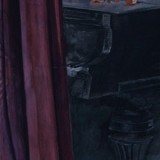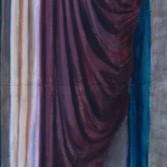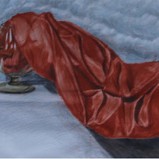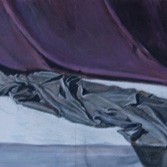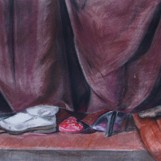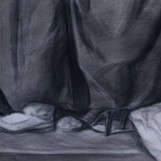Andrei Maksimjuk as a young artist has set to himself a very ambitious goal. He is dealing with classics, to be more specific – immortal classics and positions even himself in the context of the exhibition as if belonging to the company of classical artists. One could think that behind such behaviour is an extraordinarily self-assured, even insolent view of the surroundings, but especially of the events of the art history. Actually things are often not as they seem at the first glance. The artist respects and honours to a great extent the already existing creation of others. What we see at the exhibition, is a kind of a show, where between slightly old-fashioned (let’s be honest, classical) side-scenes, but often enough behind them, modern stories are being acted out to us.
The artist himself while commenting on his relationship with art has said that classical art in its different forms (music, art, ballet, etc.) is for him a superb source of inspiration. He is fascinated by the idea to introduce with the mediation of old painting traditions into his works modern echoes and to find them this way a place among all other artistic styles and influences.
Such approach to painting is called by the artist himself neo-classical and he regards his task to vitalize and modernize simultaneously things that have already existed and also to create something new. The art by Maksimjuk maybe makes the viewer to re-value and correct his current understanding of art and its functioning in time and space.
On the pictures by Andrei Maksimjuk drapery, the cloth, is often of a very great importance. Maybe it gives the evidence of the fact that the artist has prior to dealing with painting dealt with textile and fashion. Is it so or not, fabrics billow and crumble in his pictures, preserving the contours of the figures, which have left the scene and covering the remaining ones. Pictures by Andrei Maksimjuk always conceal a well-hidden secret. The artist himself has said that he tries to build up the paintings so that they would be riddles without one concrete answer. The artist selects to his paintings people and objects, which intrigue him, as a stage director selects actors into a new film, taking into account their expressive abilities and internal and external features. On his pictures he gives them totally different roles than in the real world. The artist looks at the world as the audience in a theatre does, trying to peep behind the side-scenes while watching the play. Besides all of that Andrei Maksimjuk drops onto his works single vane details that add to the intrigue and at the same time become independently existing figures. The artistic figure in his paintings is born at colliding, synthesizing of the lively and lifeless.
Andrei Maksimjuk has often emphasized his love and admiration towards the art of acting and film. Therefore his pictures seem as if illustrations of plays or as shots from films by Fellini or Eisenstein that have not been shown because of some unknown reasons. Also Polonius is standing somewhere in his picture, being hidden behind a curtain, keeping an eye on the course of events on the visible painting surface.
.png)
